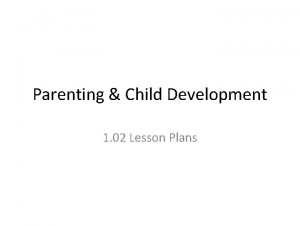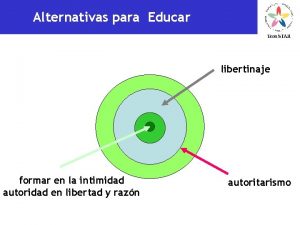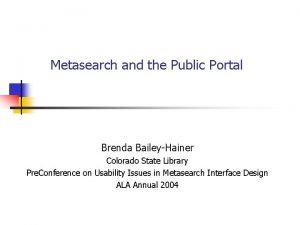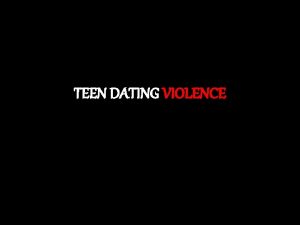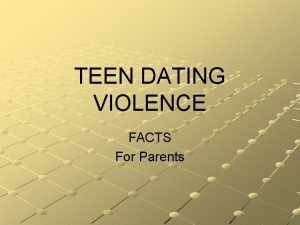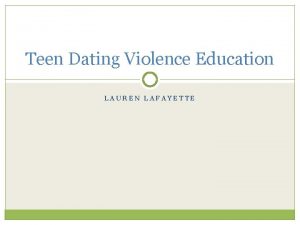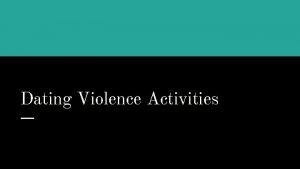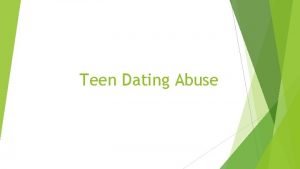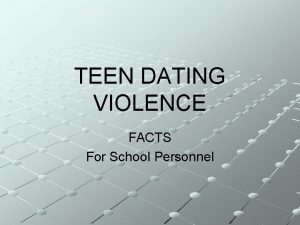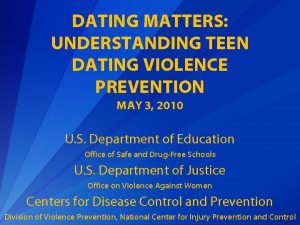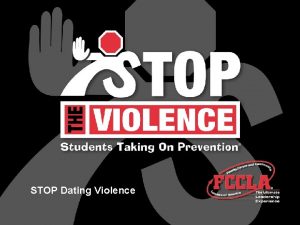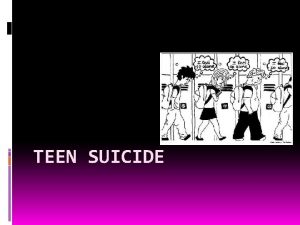TEEN DATING VIOLENCE What is dating violence Not












- Slides: 12

TEEN DATING VIOLENCE

What is dating violence? � Not simply physical violence � Threats of violence � Extreme jealousy � Controlling behavior � Sexual abuse � � Most commonly occurs in at one of the partner’s homes 19% of Chicago youth report being hit, slapped or hurt on purpose by a partner (2009 YRBS)

What does abuse look like? � Physical Abuse � Punching � Shoving � Slapping � Kicking � Pinching � Hair-pulling � Burning

What does abuse look like? � Verbal/Emotional Abuse � Name-calling � Criticizing � Swearing � Yelling � Extreme jealousy � Humiliation � Possessiveness � Isolating someone from friends and family � Giving orders � Searching someone’s phone, locker, or bedroom

What does abuse look like? � Sexual Abuse � Unwanted touching � Pressuring someone into sexual activity � Forcing someone into sexual activity � Treating someone like a sex object Note: It is unlawful for males to have sexual relations with females under the age of 18 to whom they are not married.


The Tension Phase • Victim often feels as though s/he is walking on eggshells • Victim is extra careful not to trigger an explosion • Victim senses growing tension in the abuser • Victim fears abuse could occur at any moment • Abuser may be moody or irritable

The Abuse/Explosion Phase What most people think of when they hear of an abusive relationship • Yelling, hitting, pushing, punching, rape and other forms of emotional, physical or sexual violence • Abuser may make threats of future violence against the victim, victim’s family or pets • Can also take the form of extreme psychological or emotional abuse such as insults, mind games, embarrassing someone in public or restricting their personal liberty

The Honeymoon Phase A cycle can begin or end (often known as the reconciliation phase) with this phase. • The abuser often apologizes and promises that things will be better and that he/she will change • Victim regains hope • Abuser may blame the victim for the explosion • Abuser is sweet and romantic to cement the reconciliation

Warning signs of abuse � � � � Extreme jealousy Constant put-downs Making fun of the other person Telling the other person what to do Violent temper Verbal threats Controlling what someone does, wears, or who they see � � � Possessiveness Forcing someone to “block” friends or ignore phone calls Constant calls, texts and emails Checking calls on someone’s cell phone Changing someone’s social media information or passwords

If you are abused, remember… � � � You deserve better. Do not put up with abuse. You are not alone. People from all backgrounds experience abuse. It is not your fault that you are abused. It is a choice that the abuser makes. The longer you stay the worse the abuse will become. Being drunk, high, or angry is NOT an excuse for abuse. Someone cares. Tell a trusted adult.

How to Help a Friend � � � � Do not ignore signs of abuse. Talk to your friend and express your concerns. Do not blame your friend. Listen to your friend’s feelings. Believe your friend. Let your friend know they deserve better. Encourage your friend to tell a trusted adult. Call the police if you believe your friend is in danger.








